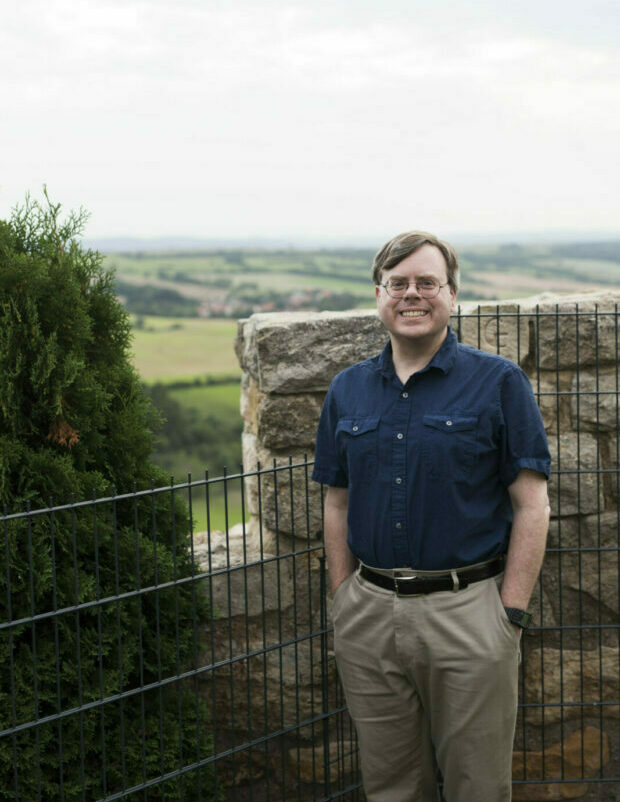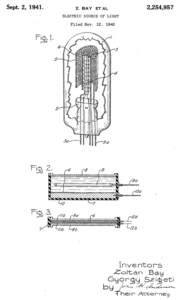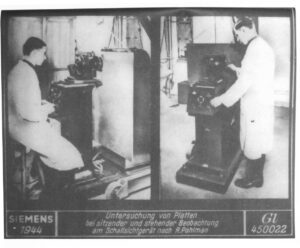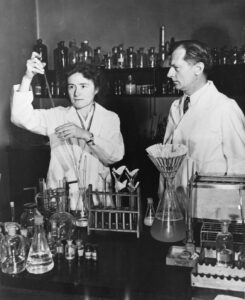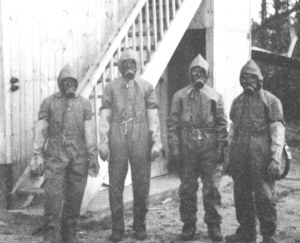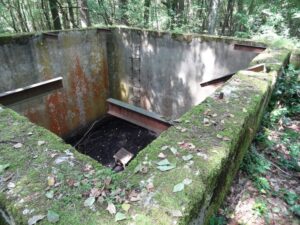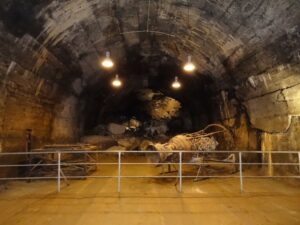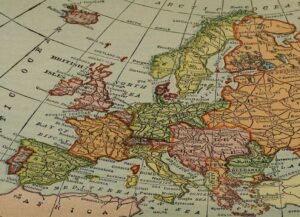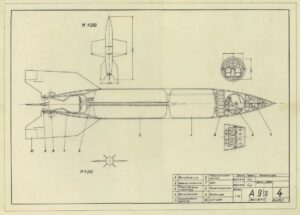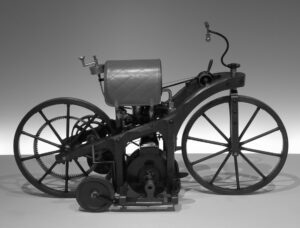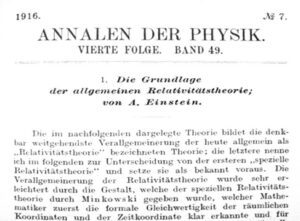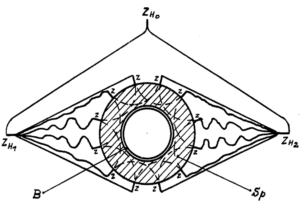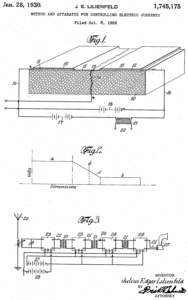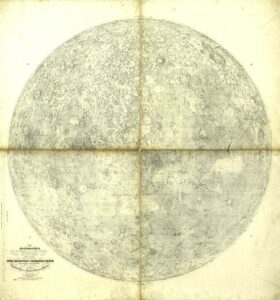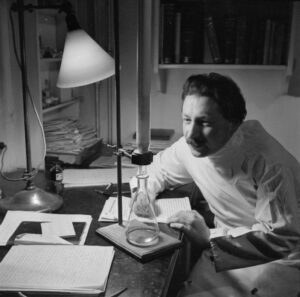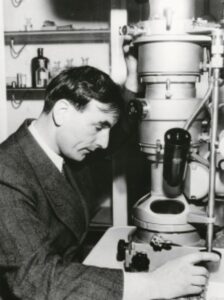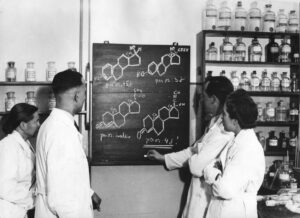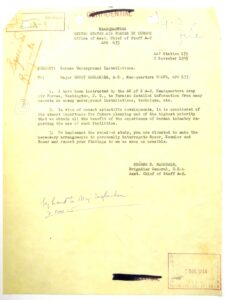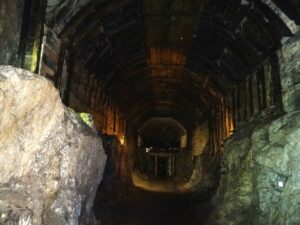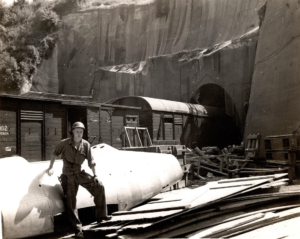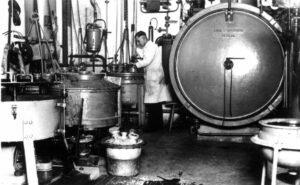Forgotten Creators (Vergessene Schöpfer) is an online reference book that was first released in February 2020. With over 6,000 pages, it covers revolutionary innovators and innovations that came out of the predominantly German-speaking scientific world during the period circa 1800–1945, and what we can learn from them that could improve innovation in the modern world. The book has been reviewed by European and American historians and scientists, and will be updated online as new information is found.
This study does not support or provide evidence for nationalist or ethnic bragging rights. The scientific research world in question spanned several nations, and even several very different types of government within a single nation’s history. The scientists had a wide variety of ancestral backgrounds. As shown in this book, the extraordinary quantity and quality of revolutionary innovations that were produced by the early German-speaking scientific world appear to have been due to certain general systemic practices that individuals, organizations, or countries around the world could harness now.
Dr. Rider is available to give presentations on any of the topics covered in Forgotten Creators, or to provide consulting services for organizations that would like to produce more revolutionary innovators and innovations. Please contact us to learn more.
Forgotten Creators may be downloaded as one 1.8 GB file containing the entire book, or as several smaller files containing individual sections. Although it takes longer to download the large file with the entire book, the advantage of that file is that it contains many hyperlinks from one page to another within the book. The smaller files do not contain the hyperlinks. Please contact us if you have problems downloading the book.
Download Slides
Slides work best when viewed in full-screen mode after being saved on your computer.
Lessons from the Forgotten Creators.
Download SlidesForgotten Creators of the German Atomic Bomb.
Download SlidesForgotten Creators of the German H-Bomb.
Download SlidesForgotten Creators of German Microelectronics.
Download SlidesForgotten Creators of German Biotechnology.
Download SlidesForgotten Creators book
*Download may take a few minutes. Please be patient.
Overview and Chapters of Forgotten Creators
Videos
Oak Ridge Hidden History: Lessons from the Forgotten Creators
View on YouTubeSmithsonian National Museum of American History: German Atomic Bomb
Download mp4 fileU.S. National Museum of Nuclear Science and History: German Atomic Bomb
View on YouTubeOak Ridge Hidden History: German Atomic Bomb (2022)
View on YouTubeOak Ridge Hidden History: German H-Bomb
View on YouTubeOak Ridge Hidden History: German Nuclear Triad, part 1 (2022)
View on YouTubeOak Ridge Hidden History: German Nuclear Triad, part 2 (2022)
View on YouTubeOak Ridge Hidden History: German Atomic Bomb (2025)
View on YouTubeOak Ridge Hidden History: German Nuclear Triad, part 1 (2025)
View on YouTubeOak Ridge Hidden History: German Nuclear Triad, part 2 (2025)
View on YouTubeHanford B Reactor Museum Association: German Atomic Bomb
Download mp4 fileArticles
Rediscovering the Forgotten Creators of the German Atomic Bomb, Part 1. Oak Ridger, March 2025
oakridger.comsmithdray1.netRediscovering the Forgotten Creators of the German Atomic Bomb, Part 2. Oak Ridger, April 2025
oakridger.comsmithdray1.netReviews of Forgotten Creators
Todd H. Rider’s Forgotten Creators is a monumental treatise about and an exciting intellectual journey through the contributions of scientists and technologists in Germany and other Central European countries and German-speaking areas to universal progress. It is thoroughly researched, meticulously documented, and presented in an easy-to-perceive way. The pre-war and pre-Nazi German system of science support has lessons that would be difficult to emulate but worthy to ponder about even today. The long-range tragic consequences in science caused by National Socialism are well demonstrated as are the benefits in the West and in the East from the exodus of Jewish scientists before and the importation of others from Germany following World War II. The book is a virtually bottomless well for mining reliable information in the history of science and technology. The ‘forgotten creators’ are no longer forgotten. Todd is to be congratulated for his accomplishment and thanked for sharing it so generously with the international community.
István Hargittai
Professor Emeritus of Chemistry, Budapest University of Technology and Economics, author of Buried Glory, Candid Science, Drive and Curiosity, Great Minds, Judging Edward Teller, Martians of Science, and The Road to Stockholm
Forgotten Creators is an examination of mid-twentieth-century German science and technology, studying the question of how this era came to be so productive. Using extensive reproduction of original materials and source accounts, the author is not only able to provide an overview of what is known about wartime activities, but is also able to indicate avenues for future historical research. The careful and comprehensive referencing permits the materials presented to be used in academic studies. A notable feature of this work is the fluid format provided by online publication, allowing revisions and new materials to be added. An especially important emphasis of the book is what can be learned from both the German-speaking scientists and the World War II era in general that could improve scientific productivity and creativity now.
Thomas Kunkle
Los Alamos National Laboratory, retired
Todd Rider has produced a meticulously researched and cogently argued tour de force on the men and the circumstances that drove the modern German Renaissance in science and technology. Brought out of the long shadow of the Third Reich, the story of this Golden Age of human enquiry is convincingly shown to have as much relevance to our present times as it did then. A remarkable achievement.
Stephen Walton
Senior Curator, U.K. Imperial War Museum
It was really with a great feeling of appreciation that I discovered the
various chapters (physics, mathematics, biology, medicine, etc.) of this
monumental work (over 6,000 pages!) by Todd H. Rider, which is dedicated to the German contributions to the advancement of scientific knowledge in the modern world.
Thousands of valuable pieces of information all collected in a unique source make
this book a precious tool both for reading and for research.
Umberto Bartocci
Professor Emeritus of Mathematics and Mathematical History, University of Perugia, Italy
Todd H. Rider’s Forgotten Creators is an encyclopedic consideration of Germany’s central place in the advancement of science and technology between 1800 and 1945. Drawing upon a wide range of sources, Rider has summarized that effort in a survey that will impress the reader just as much for the breadth of German intellectual achievement as for the influence that achievement has had upon the modern world.
George W. Cully
Retired Director, Office of History at Air University, Maxwell Air Force Base, Alabama
The scope and ambition of Forgotten Creators is really incredible. It is a work of great scholarship, an effective narrative with many historical quotes by scientists and their contemporaries that make it a very engaging read. It is richly illustrated with so many photos of researchers, where they worked, maps, patents, etc. I think this book will be of great value to historians of science and public policy institutions. I also think that as the center of economic and scientific innovation seems to be shifting from West to East, many forward-thinking people in Asia will be reading this book closely as they consider their own path ahead.
Brian Dempsey
President, Massachusetts Association of Biology Teachers
The current fragmentation of scientific disciplines up to the point of marginalization raises the question whether examples from history do exist to overcome this situation. Todd Rider attempts an answer, posing the counter question: ‘Which lessons can be learned from the most productive German-speaking inventors of the nineteenth and early twentieth century?’ His intention is not only to start a discussion on the chances to successfully transfer former educational conditions to the present scientific system but also to remember the inventors. Forgotten Creators, published online, is an impressive compilation of German achievements, covering the natural sciences, mathematics, and engineering until WWII.
Gernot Eilers
German Federal Ministry for the Environment, Nature Conservation, and Nuclear Safety
Todd H. Rider reminds us with Forgotten Creators that many key technologies like jet flight, helicopters, rocket propelled gliders, guided missiles, night vision, special alloys and welding methods, or simply synthetic rubber or polymer products that are common today were actually developed in the first half of the twentieth century in Central Europe under the control of Germany. These technologies belonged among the most valuable treasures the Allies won in the Second World War and triggered a strategic arms race among the newly emerging superpowers in the subsequent decades of the Cold War (which some say had started already in 1945 in St. Georgen/Gusen, Austria). An indispensable new reference book for all who are interested in the history of technology and the twentieth century.
Rudolf A. Haunschmied
Gusen Memorial Committee, author of St. Georgen—Gusen—Mauthausen
Todd Rider’s fundamental work, Forgotten Creators, is a
formidable counter against the oblivion or even ‘cancel science’ regarding pre-Nazi and Nazi Germany. This era’s technical and scientific achievements, although mostly along the sad Heraclid dictum ‘bellum omnium pater,’ have their impacts even today. Apparently lots of documents of this period are still classified. I am convinced that the tenacious author will bring those to light and underpin his magnum opus further.
Manfred Höfert
Former Head of Radioprotection at CERN, Geneva, Switzerland
Todd Rider’s Forgotten Creators is a really amazing overview of German technical history. Even contemporary historians will discover a lot of new references.
Rainer Karlsch
Institute for Contemporary History, Berlin, author of Leuna: 100 Jahre Chemie, Sowjetische Demontagen in Deutschland 1944–1949, Playing the Game: The History of Adidas, Uranbergbau im Kalten Krieg, Uran für Moskau, Hitlers Bombe, Für und Wider Hitlers Bombe
The book Forgotten Creators is a really impressive book, as Todd H. Rider tries to mention all relevant German-speaking scientists and engineers and their scientific fields up to 1945 in this mammoth project. In this form, nobody has dared to do this before. The author deserves my full respect for this. I am pleased that we were able to support him in his research.
Thomas Köhler
Peenemünde Historical-Technical Museum historian and head of the archive, author of Vernichtender Fortschritt: Serienfertigung und Kriegseinsatz der Peenemünder “Vergeltungswaffen”
Forgotten Creators shows us some aspects of the German culture in form and content: it reflects the spirit of the German soul in the best of the senses, focused on the recent history of science mainly in Germany and the U.S. The style reminds me of some of the biggest creations of German culture: ambitious, brave, sublime, erudite, extensive, rigorous in the analyses and exhorting in the discourses. Great! It grasps the sociological problems of science nowadays, and it offers lucid pessimistic views and wise observations of the facts. There are two different leitmotivs: 1) the modern decline of our scientific and technical advances; 2) the highest importance of German science in the most important contributions of the twentieth century scientific and technological advances. Hence, the author posits interesting hypotheses that relate the decline of science and the recent history of Germany and its influence in the world. Risk-taking interpretations that are worth reading and thinking about.
Martín López-Corredoira
Instituto de Astrofísica de Canarias, author of The Twilight of the Scientific Age
In the book Forgotten Creators, Todd H. Rider presents interesting perspectives that contribute to rethinking the story of the German nuclear project, as well as the role that heavy water had in it. The book also confirms the importance of the military actions carried out against heavy water production at Vemork.
Gunhild Lurås
Heavy Water Exhibition Curator, Norwegian Industrial Workers Museum, Vemork
Todd Rider has done a heroic job of bringing ‘secret Nazi research’ out of tinfoil-hat territory and into the realm of rigorous scholarship by compiling the vast primary-source material on a subject that has generally daunted mainstream historical research. And that shadowy field is only a sliver of the vast sweep of German science and technology covered in this monumental work. Forgotten Creators is a triumph of exactingly documented fact-finding and analysis, but it also rewards both the casual reader and the serious researcher with dynamic cross-referencing, side-by-side translations, and splendid illustrations. Rider has achieved a difficult balancing act—opening up new areas of inquiry while staying within the ever-accumulating evidence.
Diane McWhorter
Biographer of Wernher von Braun and 2002 Pulitzer Prize winner
Encyclopedia. This was the very first word coming to my mind when reading Todd H. Rider’s book. In one publication the reader is given the opportunity to review official documents as well as getting familiar with stories told by people who were involved in the development of modern technology. The book serves as a compendium of knowledge for all who are passionate about any kind of research and inventions, not only about the ones which saw the light during the Second World War and the German national socialism era. There is no doubt that many of German speaking scientists presented in the book have strongly contributed to the colossal technological progress and the development of new disciplines of science. However, when you read the book, I would encourage you not to focus on these magnificent discoveries only. Names like Wernher von Braun, Hubertus Strughold, and Otto Ambros trigger a negative connotation to many as their activities during the period of Nazi Germany are still not completely transparent. Read, think about it, and draw your own conclusions.
Marek Michalski
Author of Labor Camp Treblinka I, researcher for the Treblinka Museum and Gross-Rosen Museum
With his work, based on very comprehensive, thoroughly researched sources, Todd Rider has presented an astonishing study of the history of German science, especially in the first half of the twentieth century, which also reveals many connections that have been unjustly forgotten or little noticed. This also applies to numerous persons whose achievements are hardly known.
Günter Nagel
Author of Wissenschaft für den Krieg, Himmlers Waffenforscher, Atomversuche in Deutschland, and Das geheime deutsche Uranprojekt 1939–1945
A very valuable part of the book is devoted to the development of nuclear weapons in Germany during WWII, 1939–1945. While the histories of both the US/British Manhattan Project and the Soviet atomic project have been to a large extent declassified, little is actually known about the German work. Rider has done historians a favor by marshalling all of the evidence he could find in US, German, and Russian archives regarding the German atomic project. The inescapable conclusion is that the Germans were much farther advanced in nuclear weapons development than is generally thought.
Lee Pondrom
Professor Emeritus of Physics, University of Wisconsin-Madison, author of The Soviet Atomic Project: How the Soviet Union Obtained the Atomic Bomb
Todd Rider’s book Forgotten Creators, the creation of which I was able to observe and support for more than two years, is extraordinary in every respect. The sheer size of the book shows how important the role of German-speaking scientists was in the development of new technological advances. But it also shows the author’s will to present as complete an account of this history as possible. He has succeeded in doing so. The work therefore serves both as an introductory book and as a reference book. It is highly recommended.
Georg Ribienski
Documentation Center Manager, Jonastalverein historical society, Thuringia
Todd Rider has created an incredible document that details the technical contributions of Central Europeans in the nineteenth and twentieth centuries. The scope and scholarship are breathtaking. This document contains useful insights into how innovation and progress actually occur, as well as useful lessons that should be implemented by leaders in corporations, government agencies, and other organizations. It is past time to eliminate or minimize bureaucratic practices that obstruct innovation.
William C. Schneck, Jr.
Colonel (ret.), U.S. Army Corps of Engineers (USAR)
Forgotten Creators by Todd Rider is an extraordinary work of detailed research and new insights into the technological advances contributed by German-speaking scientists. His lengthy and in-depth study of history often overlooked or not even seen in more cursory reviews is a refreshing read. His attempt to create the fullest account possible has resulted in a fine reference book that also serves to introduce new research for the reader. Rider’s contention, right up front in the Executive Summary—that inventions and discoveries had their highest concentration of revolutionary innovations from scientists and engineers from the German-speaking central European research world in the nineteenth and early twentieth centuries—demands the reader’s attention. He then fills an enormous amount of over 6,000 pages with supporting details. Amazing subject matter and new revolutionary insights dug up through meticulous research makes Forgotten Creators a ‘must read’ for serious historians and curious researchers alike.
D. Ray Smith
Oak Ridge Historian, retired Y-12 Historian, author, and newspaper columnist
Todd Rider’s extensively researched and amazingly detailed book opens a new world for everybody interested in the history of science. Never before has anyone dug as deeply into the sources as Todd has, such that he even discovered interesting details about our father, then a young officer, and revealed some new aspects about him to us, his children. We are very grateful for Todd’s interest, dedication, and thorough research.
Andrea (Stoelzel) Edwards and Bernhard Stoelzel
The children of former Peenemünde staff member Heinz Stoelzel
This is a truly fascinating work! Dr. Rider has produced an insightful and comprehensive survey of a highly scientifically productive domain in spacetime. It is well worth understanding why that was, and what aspects of that culture should be preserved or revived.
David Strozzi
Lawrence Livermore National Laboratory
This truly voluminous study provides an in-depth overview of techno-scientific achievements and innovations which originated from the German-speaking world. It is a rich and fascinating history of the transnational circulation of knowledge over a period of no less than two centuries.
Helmuth Trischler
Head of Research, Deutsches Museum, Munich, author of Luft- und Raumfahrtforschung in Deutschland 1900—1970 and Building Europe on Expertise: Innovators, Organizers, Networkers
A most important and deserving book. Todd Rider’s research on the German rocket and nuclear programs in World War II is especially impressive because of the number and depth of the sources cited and the meticulousness of their evaluation. Really pioneering work has been done here!
Matthias Uhl
Deutsches Historisches Institut, Moscow, author of Stalins V-2: Der Technologietransfer der deutschen Fernlenkwaffentechnik and Die Organisation des Terrors: Der Dienstkalender Heinrich Himmlers 1943–1945
Todd Rider’s compendium traces the phenomenal and explosive contribution of the Central European scientific culture of the first half of the twentieth century to the modern world. The multinational renaissance was ended by the Second World War, but the participants became scientific refugees in the victorious states, driving technology around the world during the Cold War. A unique and valuable resource!
Mark Wade
Author of Encyclopedia Astronautica, www.astronautix.com
Executive Summary of Forgotten Creators
Chapter 1: Why We Should Remember What Was Forgotten. As shown in this chapter, the world does not appear to be producing truly revolutionary scientific innovations at the same rate it once did (certainly if measured in terms of revolutionary innovations per researcher or per amount of funding). Instead the academic research sector seems increasingly fixated on maximizing its rate of publishing papers regardless of their quality, redundancy, or relevance; the corporate research sector appears more and more focused on very low-risk, immediately marketable products; and the government research sector seems increasingly incapacitated by bureaucracy and budget cuts. Rather than trying to create solutions for these modern systemic problems from scratch, one may study what conditions facilitated the successes of innovators in other times and places.
Many people like to believe that their own country has been the most innovative, and indeed, inventions and discoveries have been made around the world and throughout history. Yet as illustrated by the examples in this book, the highest concentration (or at the very least, one of the highest concentrations) of revolutionary innovations appears to have come from scientists and engineers who were trained in the predominantly German-speaking central European research world in the nineteenth and early twentieth centuries. Unfortunately, the history of those innovations has been significantly obscured by World Wars I and II, the Cold War, language barriers, and cultural stereotypes, leaving the modern world less aware of the details and less able to fully reproduce the research conditions that led to so many revolutionary achievements. Therefore the objectives of this book are to:
– Elucidate the major creators and creations produced by that German-speaking world in various fields of science and engineering (Chapters 2–9).
– Determine the systemic factors that promoted so much revolutionary innovation in that particular place and time (Chapter 10).
– Evaluate the previous successes and failures of transferring that scientific knowledge and those systemic methods to other research systems (Chapter 11).
– Propose methods by which modern governments, organizations, and/or individuals could better emulate the success of the earlier German-speaking research world (Chapter 12).
A variety of study scopes and methods would be possible and enlightening, but this book focuses on revolutionary innovators who were educated in that earlier German-speaking world (defined herein as German, Austrian, and Swiss researchers; eastern European and other researchers who trained in the German-speaking world; and scientists and engineers in the closely coupled Dutch research system) between approximately 1800 and 1945, as well as their subsequent careers (in some cases to the dawn of the twenty-first century). As explained in detail in this chapter, this study does not argue that the modern research system has produced no revolutionary innovations, but rather that it can and should be improved. This study is not intended to support nationalist or ethnic bragging rights, the Third Reich, or any notion that research conditions in the German-speaking world were ever perfect. At best this book can only give a concise overview of a vast field encompassing the actions of thousands of scientists and engineers across many countries over a period of two centuries, as well as investigations into that time period by countless subsequent scholars.
The German-speaking world produced astonishing numbers of revolutionary innovators and innovations in a wide range of fields, as enumerated in eight chapters:
Chapter 2: Creators and Creations in Biology and Medicine. Advances from genetics to antibiotics.
Chapter 3: Creators and Creations in Chemistry and Materials Science. Breakthroughs from color film to synthetic rubber.
Chapter 4: Creators and Creations in Earth and Space Science. Discoveries about the universe from continental drift to stellar distances.
Chapter 5: Creators and Creations in Physics and Mathematics. Revolutionary ideas from relativity to quantum mechanics.
Chapter 6: Creators and Creations in Electrical and Electromagnetic Engineering. Inventions from semiconductors to computers.
Chapter 7: Creators and Creations in Mechanical Engineering. Systems from automobiles to submarines.
Chapter 8: Creators and Creations in Nuclear Science and Engineering. Reactions and applications from fission to fusion.
Chapter 9: Creators and Creations in Aerospace Engineering. Vehicles from jet planes to moon rockets.
Chapter 10: Creating the Creators. Based on evidence presented in this chapter, a number of specific factors within the German-speaking world promoted revolutionary innovation:
1. Science was socially glorified, from children’s activities and amateur science clubs to prestigious jobs and government-lauded scientific heroes.
2. A century-long steady exponential increase in funding gave scientists, employers, and sponsors much more freedom to pursue higher-risk and/or longer-term research.
3. Many Ph.D. students were encouraged to propose their own research topics and to pursue them independently.
4. Scientists received their final degrees nearly a decade earlier in life, and independent research funding up to two decades earlier, than modern scientists do.
5. Scientists who made major contributions to multiple disciplines, and fraternization among scientists from different disciplines, were much more common than in the modern world.
6. Instead of peer review, an autocratic yet farsighted scientific management culture of “enlightened despots” granted stable jobs and funding to the most promising creators and creations.
7. Both scientists and sponsors used a systems analysis approach to focus on the most important problems and the most effective innovations to address those problems.
8. The lack of natural resources spurred the creation of a wide range of innovative alternatives.
9. International rivalry (both economic and military) was a powerful driving force for innovation.
10. German-speaking companies were less afraid of losing their own innovations to each other than of being outstripped by foreign countries, giving them a strong motivation to innovate.
Chapter 11: Immortalizing the Creations and Forgetting the Creators. As documented in this chapter, the modern world eagerly adopted the creations of the earlier German-speaking world, yet ultimately largely forgot both the creators and the systemic approaches that had made such creations possible. Over the course of waves that occurred before, during, and after the Third Reich, all of the creations, most of the creators, and some of the systemic approaches were transferred from the German-speaking world to the United States and other countries in a German scientific diaspora. Those countries spent many decades fully perfecting and mass-producing the innovations that had been created by the earlier German-speaking world, resulting in our modern world of jet aircraft, electronics, and pharmaceuticals. Most of the creators who had already died or who remained in German-speaking areas were largely forgotten by the non-German-speaking world, which often mistakenly attributed their creations to whichever non-German-speaking individuals or organizations had acquired their technical information. Most of the creators who emigrated out of German-speaking areas led well-funded but quiet lives perfecting their creations and were also ultimately forgotten. Especially during the 1940s–1960s, the United States and other countries practiced some of the general approaches that had made the earlier German-speaking world successful, thereby cultivating new innovators and innovations of their own.
By the 1970s, most of the German-speaking creators had retired or died, their creations had been refined to the point of diminishing incremental returns, and global research systems had abandoned most of the German-like practices they had adopted, significantly reducing their efficiency at producing entirely new innovators and innovations. The Cold War as a strong motivating force for innovation had also relaxed around 1970, and any truly revolutionary new innovators (or innovations) that were produced by the global research system found it increasingly difficult to obtain proper support as time went by. From the 1990s onward, with the Cold War over and officials both public and private haggling over every research dollar while spending heavily or even wastefully in other areas, the academic, corporate, and government research sectors each became increasingly dysfunctional in their own ways.
Chapter 12: Learning from the Creators. Based on the successes of the earlier German-speaking world, this final chapter offers lessons that could be applied at any scale from the national level down to an individual’s career. At a nationwide or statewide level, the following policies could improve the ability of the modern scientific system to produce revolutionary innovators and innovations:
1. The social and financial status of science research should be elevated greatly. Better quality and greater variety of educational science experiment kits for children should be produced and more widely advertised and used. Student science competitions (especially ones like science fairs that emulate real scientific research) should be given much greater emphasis, and the winners of those competitions should be very publicly praised and rewarded. The salaries and working conditions of science and other teachers should be improved in order to attract very talented people to those positions and to recognize and reward the most effective teachers. Important scientific discoveries and inventions, as well as the people responsible for them, should be given much more coverage in television news programs, movies, newspapers, magazines, and popular internet sites.
2. If the amount of funding and permanent job positions better matched the number of graduating students and career researchers (by increasing funding wherever possible, or otherwise by limiting the number of students going into research), scientists would be able to spend much more of their time and energy doing productive research, and much less of their time and energy pursuing elusive funding and positions. It would also be much more acceptable to sponsors, institutions, and the scientists themselves for researchers to pursue longer-term work without an immediately demonstrable payoff, as well as more innovative higher-risk work that would be less guaranteed to yield results than very incremental, low-risk work.
3. Science students should be trained from an early age to be very creative and very self-reliant researchers. Students should be strongly encouraged to select their own research topics and methods. Research advisors should provide as much advice and assistance as is necessary (but only what is necessary) to ensure that their students are pursuing productive research topics using suitable methods. Research advisors should not use students as unpaid or low-wage labor to benefit the advisors’ own research grants or lists of publications.
4. The average age at which scientists receive their final degree and obtain independent research funding should be reduced back toward their early to mid-twenties. That would greatly increase the number of productive working years during which those scientists have the greatest creativity, the most energy, and the fewest non-research obligations.
5. The system should train and reward at least some percentage of multidisciplinary scientists who can make major contributions in multiple fields, apply knowledge and methods from one field to another, and use their broader view to guide fields away from less productive areas and toward more productive ones. All scientists should be strongly encouraged to make their research comprehensible to people outside their field, and to interact with scientists in other fields in a variety of environments, in order to cross-pollinate ideas among different fields.
6. While there is certainly a place for methodical peer review, entrusting virtually all funding and hiring decisions to peer review risks overlooking those creative new scientists and ideas that are so revolutionary that they cannot easily and immediately get broad consensus from the scientific status quo. The modern research system should set aside some percentage of research funding to be allocated by “enlightened despots” who are good at identifying potentially revolutionary innovators and innovations. Such enlightened despots should have the clear authority to grant financial and political support to any people or projects they deem worthy, and to grant that support for many years without having to demonstrate that there is an immediate payoff, or even that all funded research will eventually pay off. Wherever possible, any remaining peer review should be done by reviewers unaware of the researchers’ names and affiliations, so that they can more fairly evaluate the actual research in question.
7. By using systems analysis, key decision makers in government, industry, and academia could help focus more resources on the most important problems and potential solutions. If individual scientists were taught to practice systems analysis, they could use that method to guide their careers and their research projects in more promising directions, and to ensure that no potentially useful regions of the conceptual “phase space” had been overlooked.
8. In the face of dwindling natural resources and the rising long-term costs of climate change, pollution, and waste, government-funded programs and government regulations for industrial programs should prioritize the development of very innovative methods of reducing the consumption of natural resources and minimizing the creation of waste products.
9. Peaceful economic rivalry and regional pride could constructively motivate nations or states to accelerate their research programs. Regional high-tech centers could promote interactions among programs they contain, and rival high-tech centers could compete for the best scientists, projects, research funding, and economic income from resulting inventions and products.
10. Companies should view very innovative, longer-term research and development (R&D) as a worthwhile investment in staying ahead of competitors, not a financial liability whose resulting products could be copied by competitors that did not fund their own R&D. Improved tax, patent, regulatory, or other government incentives could make it much more lucrative for the first company that develops any given major innovation, and/or less lucrative for copycats.
In addition to the above lessons for national or state research systems, Chapter 12 also offers additional lessons for individual companies, organizations, and laboratories; for individual scientists and engineers; and for scholars who study past, present, and potential future innovation systems.
The appendices focus on some potentially quite advanced creations of the German-speaking world during World War II that are currently much less well understood by modern historians, and whose complexities necessitate a considerably longer treatment than could be given in Chapters 2–9:
Appendix A presents archival documents that suggest that Germany had the largest and most advanced biotechnology programs in the world at that time, was developing neural interfaces to control prosthetic limbs and weapons systems, possessed a significant offensive program in biological warfare, and discovered advanced V-series nerve agents during the war.
Appendix B gives an overview of evidence that transistors and other microelectronics innovations may have originated in the German-speaking world, and that information on those technologies may have been transferred to and exploited by Allied countries after the war.
Appendix C presents documents that appear to show that the German-speaking world developed and tested a variety of directed-energy technologies, including particle beams, electromagnetic pulse weapons, major steps toward lasers, focused sound waves for applications ranging from ultrasound imaging to acoustic weapons, and electromagnetic railguns.
Appendix D provides considerable evidence that Germany may have developed and even successfully tested fission bombs during the war (which would have made it the first country in world history to possess nuclear weapons), and that it may have even had a megaton-level hydrogen bomb in an advanced stage of development when the war ended.
Appendix E presents archival documents that appear to show that wartime Germany made considerable progress toward developing the aerospace technologies that have formed the “nuclear triad” for most of the postwar decades: intercontinental jet bombers, intercontinental ballistic missiles, and submarine-launched missiles.
Although the evidence in the appendices does not constitute conclusive proof, it should prompt further archival research to clarify the true extent of those wartime programs.
The Bibliography of over 450 pages covers relevant books, articles, government reports, and archival documents.
Keywords: Operation Paperclip, Operation Overcast, Operation Crossbow, Operation Hydra, Operation Osoaviakhim, Operation Lusty, T-Force, Alsos, Azusa, BIOS, CIOS, FIAT, JIOA, OSS, CIC, SHAEF, OSRD, NDRC, Manhattan Project, Leslie Groves, Vannevar Bush, Donald Putt, Samuel Goudsmit, Hans Kammler, Wernher von Braun, Walter Dornberger, Eugen Sänger, Irene Bredt, Hermann Teichmann, Hans von Ohain, Herbert Wagner, Rolf Engel, Werner Heisenberg, Siegfried Flügge, Kurt Diebner, Manfred von Ardenne, Paul Harteck, Georg Stetter, Erich Schumann, Walter Trinks, Hubert Schardin, Walther Gerlach, Vergeltungswaffen, Wunderwaffen, Vemork, Farm Hall, heavy water, atomic bombs, H-bombs, nuclear triad, V-1, V-2, A-4, A-9/A-10, V-101, Silbervogel, stealth, lasers, particle beams, particle accelerators, printed circuits, transistors, integrated circuits, LEDs, superconductivity, biotechnology
Please consider making a financial donation to the RIDER Institute to support our work, and please help spread the word about our programs.
Please contact us if you are interested in scheduling a paid presentation or in inquiring about other research or educational services we offer.


